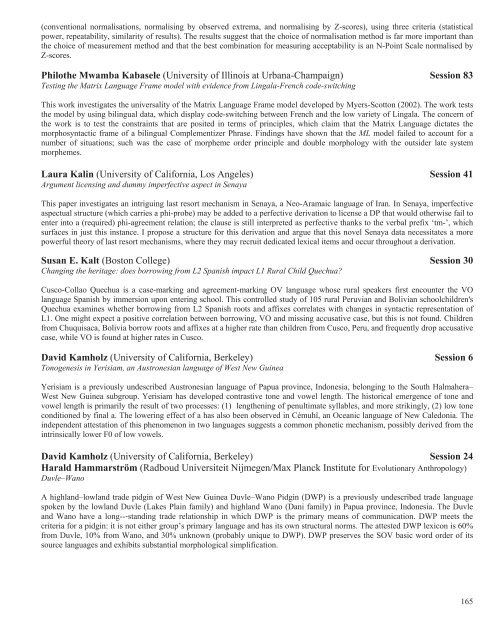here - Linguistic Society of America
here - Linguistic Society of America
here - Linguistic Society of America
Create successful ePaper yourself
Turn your PDF publications into a flip-book with our unique Google optimized e-Paper software.
(conventional normalisations, normalising by observed extrema, and normalising by Z-scores), using three criteria (statisticalpower, repeatability, similarity <strong>of</strong> results). The results suggest that the choice <strong>of</strong> normalisation method is far more important thanthe choice <strong>of</strong> measurement method and that the best combination for measuring acceptability is an N-Point Scale normalised byZ-scores.Philothe Mwamba Kabasele (University <strong>of</strong> Illinois at Urbana-Champaign) Session 83Testing the Matrix Language Frame model with evidence from Lingala-French code-switchingThis work investigates the universality <strong>of</strong> the Matrix Language Frame model developed by Myers-Scotton (2002). The work teststhe model by using bilingual data, which display code-switching between French and the low variety <strong>of</strong> Lingala. The concern <strong>of</strong>the work is to test the constraints that are posited in terms <strong>of</strong> principles, which claim that the Matrix Language dictates themorphosyntactic frame <strong>of</strong> a bilingual Complementizer Phrase. Findings have shown that the ML model failed to account for anumber <strong>of</strong> situations; such was the case <strong>of</strong> morpheme order principle and double morphology with the outsider late systemmorphemes.Laura Kalin (University <strong>of</strong> California, Los Angeles) Session 41Argument licensing and dummy imperfective aspect in SenayaThis paper investigates an intriguing last resort mechanism in Senaya, a Neo-Aramaic language <strong>of</strong> Iran. In Senaya, imperfectiveaspectual structure (which carries a phi-probe) may be added to a perfective derivation to license a DP that would otherwise fail toenter into a (required) phi-agreement relation; the clause is still interpreted as perfective thanks to the verbal prefix ‘tm-’, whichsurfaces in just this instance. I propose a structure for this derivation and argue that this novel Senaya data necessitates a morepowerful theory <strong>of</strong> last resort mechanisms, w<strong>here</strong> they may recruit dedicated lexical items and occur throughout a derivation.Susan E. Kalt (Boston College) Session 30Changing the heritage: does borrowing from L2 Spanish impact L1 Rural Child Quechua?Cusco-Collao Quechua is a case-marking and agreement-marking OV language whose rural speakers first encounter the VOlanguage Spanish by immersion upon entering school. This controlled study <strong>of</strong> 105 rural Peruvian and Bolivian schoolchildren'sQuechua examines whether borrowing from L2 Spanish roots and affixes correlates with changes in syntactic representation <strong>of</strong>L1. One might expect a positive correlation between borrowing, VO and missing accusative case, but this is not found. Childrenfrom Chuquisaca, Bolivia borrow roots and affixes at a higher rate than children from Cusco, Peru, and frequently drop accusativecase, while VO is found at higher rates in Cusco.David Kamholz (University <strong>of</strong> California, Berkeley) Session 6Tonogenesis in Yerisiam, an Austronesian language <strong>of</strong> West New GuineaYerisiam is a previously undescribed Austronesian language <strong>of</strong> Papua province, Indonesia, belonging to the South Halmahera–West New Guinea subgroup. Yerisiam has developed contrastive tone and vowel length. The historical emergence <strong>of</strong> tone andvowel length is primarily the result <strong>of</strong> two processes: (1) lengthening <strong>of</strong> penultimate syllables, and more strikingly, (2) low toneconditioned by final a. The lowering effect <strong>of</strong> a has also been observed in Cèmuhî, an Oceanic language <strong>of</strong> New Caledonia. Theindependent attestation <strong>of</strong> this phenomenon in two languages suggests a common phonetic mechanism, possibly derived from theintrinsically lower F0 <strong>of</strong> low vowels.David Kamholz (University <strong>of</strong> California, Berkeley) Session 24Harald Hammarström (Radboud Universiteit Nijmegen/Max Planck Institute for Evolutionary Anthropology)Duvle–WanoA highland–lowland trade pidgin <strong>of</strong> West New Guinea Duvle–Wano Pidgin (DWP) is a previously undescribed trade languagespoken by the lowland Duvle (Lakes Plain family) and highland Wano (Dani family) in Papua province, Indonesia. The Duvleand Wano have a long--‐standing trade relationship in which DWP is the primary means <strong>of</strong> communication. DWP meets thecriteria for a pidgin: it is not either group’s primary language and has its own structural norms. The attested DWP lexicon is 60%from Duvle, 10% from Wano, and 30% unknown (probably unique to DWP). DWP preserves the SOV basic word order <strong>of</strong> itssource languages and exhibits substantial morphological simplification.165
















